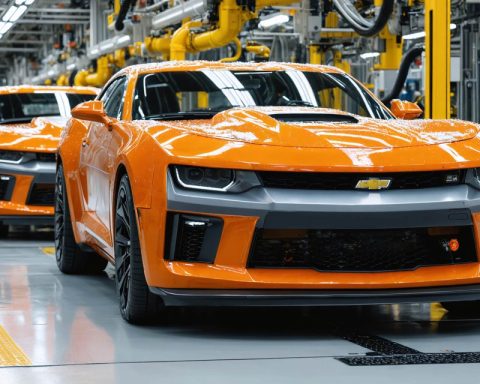- Sphere Energy introduces an AI-powered battery simulation model, revolutionizing EV battery development timelines.
- The AI model significantly reduces testing time, offering Western manufacturers a competitive edge against Asian rivals.
- Collaboration with tech giants like NVIDIA and IBM enhances innovative capabilities and technology access.
- The AI-driven approach improves efficiency in battery performance forecasting and sustainable innovation.
- Spearheaded by experts Luca Scherrer, Lukas Lutz, and Daniel Alves Dalla Corte, Sphere Energy merges chemistry, AI, and software expertise.
- The company aims for Western markets to achieve competitive parity in the global EV industry.
- Sphere Energy demonstrates the transformative potential of AI in the sustainable development of EV batteries.
From the bustling streets of Augsburg, an audacious move is unfolding in the electric vehicle world. Sphere Energy, with its groundbreaking AI-powered battery simulation model, is shattering the traditional timelines that have long shackled the EV development cycle in Europe and the US. Traditionally, the rigorous physical testing of batteries consumed three to four years—an eternity compared to the nimble efficiency of Asian manufacturers, who boast half that time.
Picture a new era of speed: Sphere Energy’s AI model slashes through the inefficiencies of conventional testing, weaving a tapestry of precision and foresight. This model not only forecasts battery performance but also extends the possibilities for sustainable and scalable innovations, carving a prosperous path for Western competition on the global EV frontier.
In collaboration with giants like NVIDIA and IBM, Sphere Energy isn’t just innovating; it’s forging alliances that empower it with cutting-edge technologies and tools. The company’s engagement with IBM’s R&D is enhancing AI-driven methodologies, reshaping everything from large-scale testing to supply chain dynamics—each step a testament to the power of collaboration in an ever-competitive industry.
What truly elevates this AI-powered simulation is its agile, data-driven approach, equipped to embrace rapid technological leaps. Spearheaded by a trio of brilliant minds—Luca Scherrer, Lukas Lutz, and Daniel Alves Dalla Corte—blending chemistry, AI, and software wizardry, the team at Sphere Energy is steering the Western market towards parity with its Asian rivals.
The takeaway? In this high-speed race of innovation, Sphere Energy beckons with a dramatic promise: that AI, when woven with expertise and collaboration, holds the transformative key to a competitive and sustainable battery development future. The road to revolution is clear, and it’s AI that’s driving the charge.
The AI Revolution in Electric Vehicle Battery Development
How-To Steps & Life Hacks for Battery Simulation Models
1. Identify Key Characteristics: Before engaging with AI models, identify the specific battery characteristics you need to test, such as energy density, cycle stability, and temperature tolerance.
2. Data Integration: Integrate diverse datasets, including historical performance data and new experimentation feedback via IoT sensors from battery testing labs.
3. Model Training: Use platforms like NVIDIA’s AI frameworks to train models on the integrated data, ensuring that the simulations are predictive of real-world performance.
4. Iterative Simulation: Conduct iterative simulations to refine and improve model accuracy, applying advanced machine learning techniques.
5. Feedback Loop: Establish a feedback loop where outputs are consistently analyzed against actual performance to optimize the AI model’s learning curve.
Real-World Use Cases
– Faster Prototyping: Companies can prototype electric vehicle batteries more rapidly by using Sphere Energy’s advanced simulations, significantly reducing time-to-market.
– Predictive Maintenance: By predicting potential failures or performance drops before they occur, manufacturers and consumers can engage in proactive battery maintenance.
– Supply Chain Optimization: AI can optimize the supply chain by predicting demand surges and aligning production schedules accordingly.
Market Forecasts & Industry Trends
According to recent market analyses, the global EV battery market is expected to grow at a CAGR of 25% from 2023 to 2030, largely driven by advancements from companies like Sphere Energy. Analysts forecast heightened collaboration between tech giants and battery manufacturers as AI increasingly intersects with battery development.
Features, Specs & Pricing
Sphere Energy’s AI platform emphasizes:
– High-Precision Simulations: Offering up to 99% accuracy in battery life predictions.
– Integration with Cloud Computing: Utilizing IBM’s and NVIDIA’s infrastructure, capable of handling terabytes of simulation data.
– Modular Pricing: Scaled based on the scope and volume of the simulation tasks, making it affordable for startups and large enterprises alike.
Security & Sustainability Insights
– Data Security: Employing state-of-the-art encryption from partnerships with IBM ensures data integrity and protection.
– Environmentally Friendly: By reducing the need for physical prototypes, the carbon footprint of the battery development process is significantly lowered.
Pros & Cons Overview
Pros:
– Reduced development cycle time.
– High precision in simulation.
– Collaborative synergy with top tech companies.
Cons:
– Requires significant upfront investment in AI infrastructure.
– Dependence on accurate data inputs for simulation effectiveness.
Actionable Recommendations
– Leverage Sphere Energy’s simulation models to accelerate product innovation cycles.
– Engage in partnerships with AI frontrunners, to bolster the robustness of your industry applications.
– Monitor industry trends and continuously adapt strategies to stay at the forefront of technological advancements.
For further insights into AI-driven developments in the tech industry, explore the resources available at NVIDIA and IBM.







